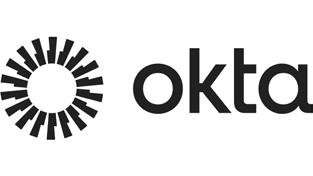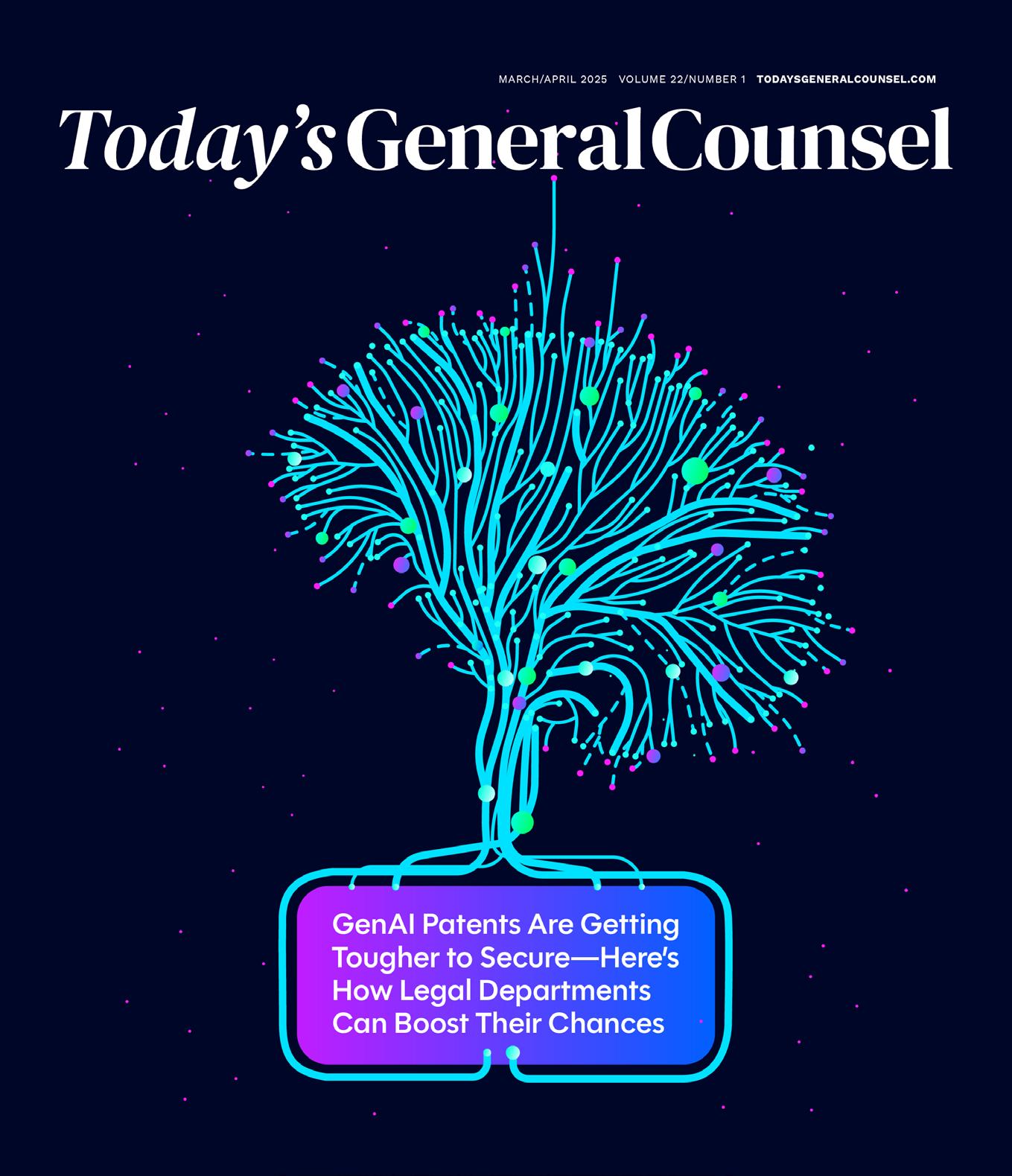



















Generative AI is everywhere. Every day, we learn about new capabilities, groundbreaking applications, and emerging challenges tied to this revolutionary technology.
As the possibilities for AI expand, so does the surge in patent applications. The US Patent & Trademark Office is scrambling to keep up with the flood of filings tied directly to AI technology. The upshot? It’s likely to become more difficult to obtain new GenAI-related patents going forward.
Michael R. Anderson of Marshall Gerstein explores the dynamic in his insightful cover story for us.
“One main reason that it could become more challenging to obtain a patent is that the growing number of filings gives examiners more prior art to reference when evaluating anticipation and obviousness,” he writes. “As they become more familiar with the technology, we will probably see more – and tougher – rejections related to subject matter eligibility.”
Anderson goes on to explain what you and your legal team should keep in mind when filing for AI patents on behalf of your company to maximize your chances of your application succeeding. Like with so many other things, the devil is in the details.
While patent filings involve meticulous detail, so too does the world of litigation funding. In another article, Jeffery Lula of GLS Capital dives into the critical importance of precise valuation in the context of commercial lawsuits. As a litigation financer—someone who invests in commercial lawsuits—Lula spends his days evaluating complex cases. He argues that in-house counsel should adopt a similarly objective approach when assessing litigation risks.
“In-house attorneys need to determine whether the risk-adjusted value or exposure justifies the distraction and budget for their c-suite executives,” Lula writes. “In my experience, these attorneys often take an ad hoc approach to valuation—which can lead to biased or imprecise evaluations.”
We ensure that each article we publish contains actionable insight you can share with your team. The edition also covers topics such as “hell or high water” clauses in M&A deals, weight discrimination, contract playbooks, and the use of AI in courtroom
Finally, don’t miss our exclusive interview with Melanie Ronen, Partner at Stradley Ronon Stevens & Young, LLP, featured on our companion platform, Today’s Managing Partner
Ronen shares valuable insights about key employment law and regulation trends and compliance challenges. This primer on what to expect in the workplace in 2025 will be of interest to both the law firm community (the Today’s Managing Partner audience) as well as in-house teams.
Remember that this issue of the magazine is just a selection of the content we produce each day. Stay ahead of the curve—check our website regularly for the latest updates, and follow us on LinkedIn and X to join the conversation and keep up with cutting-edge thought leadership
Thanks for reading,
Amanda Kaiser Editor-in-Chief
1

9
9 GenAI Patents Are Getting Tougher to Secure—Here’s How Legal Departments Can Boost Their Chances
By Michael R. Anderson
The surge in GenAI patent applications means it will likely become more difficult to obtain new GenAI patents going forward. Learn about the best way for legal departments to boost their chances of securing patents linked to the fast-evolving technology.
LITIGATION
12 Why GCs Should Approach Litigation Valuation Like a Litigation Funder
By Jeffery Lula
Take a page from the playbook of litigation funders and apply their methodology to litigation valuation at your organization.
14 Decision in Microsoft Copilot Case Helps Define Use of AI in the Courtroom
By Theodore Brown
When is it appropriate to use AI in the courtroom and in other legal work? Read what you need to know about the “Matter of Weber” to guide your team.

14
16 What the Kroger-Albertsons Deal Teaches Us About “Hell or High Water” Clauses
By Jeffery M. Cross
Learn why the recently blocked Kroger-Albertsons deal provides valuable lessons about how to handle antitrust risks in M&A agreements, especially “hell or high water” clauses and divestments.

20
COLUMN/EMPLOYMENT LAW IN FOCUS
20 Is Your Company Sanctioning Weight Discrimination? Don’t Cite Hooters in Your Defense
By Leah M. Stiegler and Anne Bibeau
Learn more about what you and your organization need to know about weight discrimination and why you shouldn’t cite Hooters in your defense.
INTERVIEW
24 Law Firm Partner
Melanie Ronen Talks Employment Law and Regulation in 2025
Discover insights on employment law and regulation in Today’s Managing Partner’s exclusive interview with Melanie Ronen. Read about key legal trends, compliance challenges, and what’s next for the workplace.

L. Ronen Partner and Chair
Stradley Ronon Stevens & Young, LLP Employment and Labor Practice
SPONSORED
Presented by LEGAL OPERATIONS
18 How Contract Playbooks Close the Reliability Gap in AI Contract Review

By Bärí A. Williams
Playbooks provide a clear, actionable framework for contract review that ensures every contract reflects your organization's priorities, no matter who’s reviewing it.
Paired with AI, playbooks let you delegate the repetitive, line-by-line work to technology while your team focuses on the strategic calls that really matter.
As digital evidence grows in complexity and volume, KLDiscovery stands as the pioneer in eDiscovery excellence. For over three decades, we’ve helped law firms, corporations, and government agencies navigate their most demanding legal and regulatory challenges. With 26 strategic locations across 17 countries, we combine advanced technology with deep forensic expertise to turn raw data into actionable intelligence. Our comprehensive eDiscovery and compliance solutions don’t just mitigate risk—they create strategic advantages, optimize costs, and ensure defensible results. All backed by our signature 24/7 white-glove support, making KLDiscovery the trusted partner for organizations worldwide.
Regulatory Investigations and Compliance
Cross-Border Litigation and Investigations
Advisory Consulting Services
Cyber Incident Response
EXECUTIVE EDITOR
Bruce Rubenstein
CHIEF OPERATING OFFICER
Stephen Lincoln
DIGITAL EDITOR
Catherine Lindsey Nienhouse
CONTRIBUTING EDITORS AND WRITERS
Michael R. Anderson
Anne Bibeau
Theodore Brown
Jeffery M. Cross
Jeffery Lula
Leah Stiegler
Bärí A. Williams
EDITOR-IN-CHIEF
Amanda Kaiser
SENIOR EDITOR
Barbara Camm
FEATURES EDITOR
Jim Gill
MANAGING DIRECTOR OF CLIENT PARTNERSHIPS & INITIATIVES
Lainie Geary
WEB EDITOR
Jessica Bajorinas
ART DIRECTION & PHOTO ILLUSTRATION MPower Ideation, LLC
ACCOUNT EXECUTIVE
Stella Vargas
DATABASE MANAGER
Patricia McGuinness
EDITORIAL ADVISORY BOARD
Dennis J. Block GREENBERG TRAURIG LLP
Thomas W. Brunner WILEY REIN LLP
Mark A. Carter DINSMORE & SHOHL LLP
Jeffery Cross SMITH, GAMBRELL & RUSSELL LLP
Jamie Gorelick WILMERHALE LLP
Robert L. Haig KELLEY, DRYE & WARREN LLP
Robert C. Heim DECHERT LLP
Sheila Hollis DUANE MORRIS LLP
SUBSCRIPTION
Subscription rate per year: $199
For subscription requests, email subscriptions@todaysgc.com


David A. Katz WACHTELL, LIPTON, ROSEN & KATZ Nikiforos Iatrou MCCARTHY TETRAULT LLP
Steven F. Molo MOLOLAMKEN LLP
Robert A. Profusek JONES DAY
George D. Ruttinger CROWELL & MORING LLP
Jonathan S. Sack MORVILLO ABRAMOWITZ GRAND IASON & ANELLO PC
Victor E. Schwartz SHOOK, HARDY & BACON LLP
Jonathan D. Schiller BOIES SCHILLER FLEXNER LLP
REPRINTS
For reprint requests, email Lisa Payne: lpayne@mossbergco.com Mossberg & Company Inc.
All rights reserved. No part of this publication may be reproduced or transmitted in any form or by any means, electronic or mechanical, including photocopy, recording, or any information or retrieval system, without the written permission of the publisher. Articles published in Today’s General Counsel are not to be construed as legal or professional advice, nor unless otherwise stated are they necessarily the views of a writer’s firm or its clients.
Today’s General Counsel (ISSN 2326-5000) is published six times per year by Nienhouse Group Inc., 110 N Upper Wacker Dr, Chicago, IL 60606. Image source: iStockphoto | Copyright © 2025 Nienhouse Group Inc.
To submit an article, go to todaysgeneralcounsel.com/submissions
By MICHAEL R. ANDERSON

Exploding interest in artificial intelligence has sparked a wave of innovation, leading companies to develop a host of new products and technologies. Some 300 distinct GenAI patent families have been filed since the start of 2018, according to the US Patent & Trademark Office’s patent application database . This surge in applications means it will likely become more difficult to obtain new GenAI patents going forward.
One main reason that it could become more challenging to obtain a patent is that the growing number of filings gives examiners more prior art to reference when evaluating anticipation and obviousness. As they become more familiar with the technology, we will probably see more — and tougher — rejections related to subject matter eligibility.
Legal departments should consider how the increasing challenges of patenting GenAI inventions might shape their approach to preparing patent applications. This is a crucial point because onwce a nonprovisional application is filed, the applicant is locked into the material it contains.
Wednesday, March 18
1:00 PM ET

Struggling with slow approval workflows, limited negotiation visibility, or inefficient contract processes?
This fast-paced, 30-minute webinar will deliver actionable strategies to help you streamline contract management and drive productivity.

Michael Donnely Sales Enablement Specialist, CobbleStone Software
In partnership with:

Key takeaways:
Enhance Collaboration. Simplify document sharing and version control
Automate Alerts & Reminders. Stay ahead of deadlines effortlessly
Accelerate Approvals. Leverage secure eSignatures for faster execution
Improve Visibility. Gain clear oversight of contract ownership and progress
Boost Efficiency. Optimize workflows with powerful automation tools
Join us to discover how modern contract management can eliminate bottlenecks and enhance operational efficiency.
Register now to attend live, or to ensure you receive the recording if you can't make it!
Here are three actionable pieces of advice to keep in mind when filing AI patents:
1
Legal teams should prioritize applications with highly detailed, specific descriptions that start with narrower claim scopes or include fallback positions right from the beginning. This is important because the field of GenAI is getting more crowded and the “low-hanging fruit” of simpler inventions is already claimed.
Legal departments should consider how the increasing challenges of patenting GenAI inventions might shape their approach to preparing patent applications.
2
Applications should focus on details that explain how an underlying system operates or is structured. These descriptions tend to carry more weight during prosecution than simply describing results, the nature of the training data, or the input data. By emphasizing this level of detail, your department can better navigate the tougher patent landscape ahead. For instance, details describing how a new GenAI system improves on existing computer technology or how existing models process or pre-process input data are the most useful for overcoming prior art and subject matter eligibility rejections.
Prefer to read this online? Click here.
If time is of the essence, consider the USPTO’s provisional patent application filing process. Given the fast pace of GenAI developments, assembling all the necessary details at the desired filling time can be challenging. Applicants can add new information and product developments for up to a year when filing non-provisional or PCT (for international) applications. Even though the newly disclosed elements will likely have a different date for prior art purposes, this filing process lets applicants set an earlier date for at least a portion of the invention. Many patent applicants miss out on this process’s benefits by skipping a provisional application or converting it to a non-provisional one with little to no substantive updates.
In conclusion, as obtaining GenAI patents becomes more complex for legal departments, future applicants and inventors should provide more details in their patent applications and narrow their claim scope to increase the probability of obtaining an allowed patent.

Michael R. Anderson is a patent attorney in Marshall Gerstein’s Electrical & Computer Technologies Group. He takes a holistic approach to portfolio management and intellectual property strategy development, drafts opinions on invalidity and non-infringement issues, and advises on post-grant review proceedings. He can be reached at manderson@marshallip.com.

THOUGHT LEADERSHIP, INTERVIEWS AND THE LATEST LEGAL NEWS CURRENT BUSINESS DEVELOPMENTS FOR GCs AND IN-HOUSE COUNSEL Subscribe
By JEFFERY LULA

As a litigation funder—a financer who invests in commercial lawsuits—I spend all day analyzing complex litigation. My team and I objectively evaluate the merits and the various known and unknown risks associated with cases. In essence, litigation funders
succeed through their repeated success in underwriting lawsuits. In-house counsel should consider taking that same approach to litigation valuation.
In-house attorneys need to determine whether the riskadjusted value or exposure justifies
the distraction and budget for their c-suite executives. In my experience, these attorneys often take an ad hoc approach to valuation—which can lead to biased or imprecise evaluations.
When valuing litigation, it is useful to break down the components of
the litigation. These components include the legal merits, damages, duration, and collectability.
The legal merits of a lawsuit, while complex, is perhaps the most straightforward component for valuation. Litigators are skilled at roughly estimating the likelihood of success. But how do you add quantitative rigor to this approach? To start, litigation risk is lumpy. There
When valuing litigation, it is useful to break down the components of the litigation. These components include the legal merits, damages, duration, and collectability.
are multiple milestones in a lawsuit. A common way to evaluate the merits is to assign a probability to each milestones. Houlihan Lokey echoes a version of this approach in their article “A Valuation Framework for Litigation Finance Assets.” What are the odds of losing at motion to dismiss, motion for summary judgment, trial, and appeal? This framework reflects that the value of a case can change dramatically with a single ruling. When feasible, detailing these milestones and probabilities provides a more nuanced picture of the legal merits, and it can help non-litigators visualize the risks.
As for damages, trial lawyers can usually derive a damages estimate or at least a range. The issue for litigation valuation is that damages are not created equal. Some calculations, like future lost profits for a startup business, are necessarily speculative. This nuance regarding the certainty of damages is key to valuing a case. Winning on liability and winning a large judgment are not the same.
At the outset of a lawsuit, duration can be difficult to predict. A case can move quickly until an overworked judge sits on a motion for six, twelve, or eighteen months. Similarly, one disconnect I find with respect to duration is the import of the scheduling order. Non-litigator clients often believe that the court’s scheduling order is firm and reliable. Litigators understand that scheduling extensions are commonplace. When analyzing the value of litigation, which naturally includes an estimate and adjustment for duration, it is important to determine whether the current scheduling order is likely to change.
The collectability of a judgment is not discussed as much as the earlier components. This is especially true with commercial lawsuits between sophisticated companies. I would add a reminder to in-house counsel to inquire whether the defendant entity is expendable. There are plenty of examples of large corporate entities letting a single affiliate dissolve for business or litigation purposes. Collectability can be more complicated than knowing that the defendant is an affiliate of a wealthy company.
Prefer to read this online? Click here.
As a final point, I have talked to hundreds of litigants who are looking for advice or are interested in funding to monetize or defray the costs of litigation. I keep hearing the same story: they have a potential affirmative lawsuit, but it does not seem to be worth the distraction or the cost. That decision is a valuation exercise—the value of the case versus the downside. Remember, when in-house counsel can accurately value and pursue lawsuits, they become a revenue generator for the company.

Jeffery Lula is a Principal at GLS Capital — a large litigation funder headquartered in Chicago. He oversees funding to both law firms and litigants for commercial matters. He is ranked by Chambers & Partners as a leading litigation funder in the United States. He can be reached at jlula@glscap.com
By THEODORE BROWN

The integration of AI in the legal field has prompted both optimism for enhanced efficiency and concerns regarding ethical and procedural reliability. Attorneys and experts are increasingly using tools like ChatGPT, Microsoft Copilot, and various open-source AI models in their work. However, the scope and limitations of these tools, particularly in sensitive areas like expert testimony, remain under scrutiny. The question is when is it appropriate to use AI
in the courtroom and in other legal work?
A recent decision out of New York in a case called “Matter of Weber” offers critical insight into these limitations. In the case, a financial expert’s reliance on AI tools contributed to the disqualification of their testimony. The court assessed allegations of fiduciary breaches by an executor of a trust, with the objecting party (Objectant) presenting a financial expert to evaluate anticipated economic damages. This expert used
Microsoft Copilot as a secondary check for his calculations, a decision that ultimately contributed to the judge’s decision to disqualify him.
The financial expert was found unreliable based on the following factors:
1. Lack of Standard Practices: The expert admitted he did not employ industry-standard calculations due to cost and time constraints.
2. Inadequate Qualifications: The
judge deemed the expert unqualified based on deficiencies in his education, training, and familiarity with the relevant calculation methodologies.
3. Confusion Over Damage Types: The expert could not clarify if his calculations were for lost profits or capital losses.
4. AI-Driven Calculations: Although AI’s use was not the sole basis for disqualification, the judge’s order highlighted concerns over the expert’s reliance on Microsoft Copilot.
The judge’s ruling emphasizes that open-sourced AI tools like Microsoft Copilot, are unreliable sources for expert witnesses, primarily because they are not easily verifiable. As I’ll discuss more in a moment, there is a place for closed-source AI tools, which are useful for streamlining tasks, but no AI tool can replace the need for a qualified expert with comprehensive knowledge of their calculations. The use of open-source AI compounded the expert’s other errors, but it was his fundamental lack of qualification that led to his disqualification.
AI’S ROLE IN EXPERT TESTIMONY: BENEFITS AND LIMITATIONS
This case highlights the limitations of current, particularly open-sourced AI tools for complex analytical tasks in expert testimony, particularly in high-stakes legal contexts. While closed-source AI can significantly enhance an expert’s workflow, especially in tasks requiring data organization and summarization, it is not yet equipped to replace human judgment in nuanced calculations.
Closed-source AI’s capabilities are particularly advantageous for foundational tasks in expert analysis:
• Document Indexing: AI can sort and categorize large volumes of documents.
• High-Level Summarization: Closed-source AI tools provide summaries, making it easier to understand document contents quickly.
• Enhanced Searchability: Closedsource AI enables deep searches in hard-to-index formats like PDFs, images, and videos, adding efficiency and precision.
• Timeline Creation: Closed-source AI can streamline the process of constructing timelines, essential in legal analysis and case preparation.
However, as demonstrated in Matter of Weber, open-source AI tools like Microsoft Copilot may not reliably perform complex, specialized calculations without oversight. Additionally, no AI should replace an expert’s own understanding and verification of their analytical processes.
1. Use Closed-Source AI for Preliminary Tasks: Employ closedsource AI for initial data sorting, document summarization, and cross-referencing, rather than primary calculations or critical analysis.
2. Ensure Transparency: Experts should be prepared to explain both their methodologies and any
Prefer to read this online? Click here.
AI usage, demonstrating a clear understanding of AI’s limitations.
3. Avoid Sole Reliance on AI for Complex Calculations: For higher-level math or domain-specific calculations, experts should prioritize traditional, peer-reviewed methods and apply closed-source AI as a supplemental tool.
4. Maintain Qualification Standards: AI cannot compensate for gaps in an expert’s qualifications. Courts continue to rely on the Federal Rules of Evidence to assess an expert’s foundational knowledge, training, education, skill and experience, which remain essential.

Theodore (Teddy) Brown serves as the Managing Director of Damages at iDS, leading the charge in forensic accounting and commercial damages. Brown transforms complex financial data into insights that empower clients and counsel alike.
By JEFFERY M. CROSS

The recently blocked KrogerAlbertsons deal , a $24.6 billion merger that would have created a massive grocery store operator, provides valuable lessons about how to handle antitrust risks in M&A agreements. More specifically, it highlights the significance of “hell or high water” clauses that require the parties to take whatever steps are necessary to remove antitrust impediments, including divesting assets. Albertsons has claimed that Kroger violated these provisions of the deal.
In October 2022, Kroger and Albertsons publicly announced their merger. Kroger was the largest
traditional grocery store chain in the United States. It had 2,700 stores across 35 states and Washington DC. Albertsons was the second largest supermarket chain in the United States with 2,269 stores in 34 states and Washington DC.
Ultimately, the Federal Trade Commission and various states filed suits in both federal and state courts to block the merger. The federal court issued its ruling on December 10, 2024 granting the FTC’s motion to enjoin the merger. Shortly thereafter on the same day, the Washington state court also enjoined the merger. The next day, Albertsons withdrew from the merger and filed suit in Delaware Court of Chancery alleging
that Kroger breached the merger agreement. Albertsons seeks billions of dollars in damages.
Prior to the public announcement of the merger, the parties negotiated a merger agreement. Albertsons alleges it knew from the start there would be potential antitrust concerns, and a “robust” divestiture of stores would be required. Consequently, Albertsons alleges it wanted to ensure Kroger would be obligated to take all steps necessary to obtain government approval. Albertsons sought language in the merger agreement that Kroger would be obligated to use its “best efforts to take . . . any and all actions necessary to avoid, eliminate, and resolve any impediments under the Antitrust Law . . . .”
As the complaint alleges, under this provision, “Kroger was agreeing to remove antitrust impediments ‘come hell or high water.’” The parties also negotiated a “break fee” of $600 million if the agreement was terminated for various reasons. In addition, the agreement contained a provision permitting “benefit of the bargain” damages for a “Willful Breach” of the merger agreement.
The complaint also alleges the parties negotiated a cap of 650 stores Kroger would have to divest. But Albertsons contends there was no cap on the non-store assets that could be transferred in a divestiture, such as “banners” or store brands, private labels, IT and data assets, distribution assets and manufacturing centers.
It is standard practice for merging parties to meet early and often with the antitrust agency responsible for the case and present their arguments for the merger and a divestiture package if appropriate. Indeed, in a $17 billion merger in which I was involved, we made a presentation to the Department of Justice before the Department of Justice and the FTC had determined what agency would handle the merger. (We guessed correctly because the DOJ ultimately handled the matter). We also presented at that time a divestiture package designed to satisfy the government’s antitrust concerns. This divestiture package ultimately resulted in a consent decree.
Albertsons alleges Kroger ignored the analysis of their experts as to the store divestitures necessary to pass antitrust scrutiny and instead cherry-picked stores because of their poor financial performance. And throughout the process, Kroger refused to divest enough stores to eliminate the presumption of anticompetitive effects in several markets. Indeed, the complaint noted Kroger’s economist was forced to concede at trial that nearly two dozen markets would have presumptively anticompetitive effects even accounting for the divestiture. Such
an admission by itself was sufficient to torpedo the merger.
Both Albertsons and the FTC also condemned Kroger’s selection of C&S Wholesale Grocers as the buyer of the divested stores. Both parties asserted C&S had experience mainly as a wholesaler and its limited retail experience had been unsuccessful. Indeed, Albertsons noted in its complaint that Kroger passed up another buyer who Kroger’s own executives found superior. Furthermore, both Albertsons and the FTC argued C&S had not been provided the nonstore assets necessary to compete, including recognized store brands, private labels, distribution infrastructure and IT.
Ultimately, the federal district court in Oregon and the state court in Washington agreed with these assertions, leading to the injunctions.
Kroger has issued statements arguing that Albertson’s complaint is meritless. Ultimately, which version of the Kroger-Albertsons deal will prevail is currently in the hands of a Delaware judge. However, the trial of these issues will provide valuable lessons in the risks and rewards of “hell or high water” clauses as well as the process necessary to convince an antitrust regulator to approve a deal.
Important takeaways about antitrust risks in M&A agreements:
• Clear and comprehensive antitrust provisions are essential: Merger agreements should clearly set forth provisions for antitrust risk. These might include “hell or high water” provisions, which obligate the parties to take all
Prefer to read this online? Click here.
necessary actions to resolve regulatory issues.
• Divestitures, if required, must be meaningful for antitrust approval: Divestitures must be designed to eliminate competitive harm and satisfy antitrust regulators. Simply divesting underperforming stores or selecting weak buyers will not be sufficient.
• Buyer selection in divestitures matters: The chosen buyer must have the capability to effectively operate the divested assets to restore competition. Selling to an underqualified buyer can lead to regulatory pushback and deal failure.
• Proactive engagement with regulators is key: Early and frequent communication with antitrust authorities is critical. Parties should proactively present their case and offer solutions to address concerns.
• Legal and financial consequences of breaching the agreement: Failing to comply with merger obligations, particularly those tied to antitrust concerns, can result in significant legal and financial penalties, including breach of contract claims and damages

Jeffery M. Cross is a columnist for Today’s General Counsel and a member of the Editorial Advisory Board. He is Counsel in the Litigation Practice of Smith, Gambrell & Russell, LLP. Cross was a Partner at Freeborn & Peters, which merged with SGR in 2023. He can be reached at jcross@sgrlaw.com.
By BÄRÍ A. WILLIAMS | PRESENTED BY

In my years working as an in-house attorney, I’ve seen how contract review can make or break deals. It’s not just about finding legal risks—it’s about doing it quickly enough to keep up with the business. But here’s the problem: reviewing contracts at scale is messy. Without a clear process, teams end up reinventing the wheel for every agreement, and inconsistencies creep in. I’ve seen deals delayed because a key clause slipped through the cracks or because our team couldn’t agree on what “acceptable” looked like.
AI is supposed to help with this, but let’s be honest: without the right guardrails, it’s just a fast way to get inconsistent results. On the flip side,
manual reviews rely too heavily on institutional knowledge, and when your star reviewer is out of the office, the process grinds to a halt. The solution? Playbooks. They provide a clear, actionable framework that ensures every contract reflects your organization’s priorities, no matter who’s reviewing it. Paired with AI, playbooks let you delegate the repetitive, line-by-line work to technology while your team focuses on the strategic calls that really matter.
Think of a contract playbook as your legal team’s cheat sheet. They’re
guides that spell out how your organization handles key contract terms—what’s a “yes,” what’s a “no,” and what’s up for negotiation. A playbook gives everyone a consistent roadmap for tackling contracts, so you’re not reinventing the wheel with every review. Whether your team uses it on its own or pairs it with AI tools, a playbook helps focus attention on what really matters and makes decisions faster and more reliably.
Without playbooks, contract reviews can be inconsistent and inefficient, often leading to deviations
from company standards and increased risk exposure. Playbooks solve this by:
• Standardizing reviews: Ensuring uniform application of legal and business policies.
• Improving efficiency: Reducing the time spent reviewing repetitive clauses.
• Mitigating risks: Consistently identifying potential red flags and inconsistencies early in the process.
Despite their benefits, many organizations lack comprehensive playbooks. According to LegalOn’s 2025 State of Contracting report, 95% of organizations have gaps in their playbook coverage. This gap hampers the ability to scale contract review processes effectively, especially in high-volume environments. Organizations without playbooks often struggle with inconsistent contract terms, prolonged review cycles, and greater exposure to legal risks. The playbook gap represents not just a lack of documentation but a missed opportunity to implement efficiency and empower your business partners, contract managers, and paralegals at scale.
For organizations ready to develop playbooks, the process can be broken into actionable steps:
1. Start with the basics: Identify recurring clauses across your contracts. Focus on the “Great 8” contentious clauses, which include Intellectual Property, Limitation of Liability, Indemnification,
Confidentiality, Data Protection, Warranties, Payment Terms, and Effects of Termination.
2. Define standards: For each clause, outline preferred language, fallback positions, and unacceptable terms.
3. Organize for accessibility: Create a structure that allows users to quickly find relevant guidance.
4. Test and refine: Apply the playbook in real contract reviews, gather feedback, and make improvements.
5. Automate for scalability: Integrate your playbooks with AI-powered tools to ensure consistent application at scale.
AI tools are powerful for contract review, but they’re only as good as the instructions they follow. That’s why playbooks are critical—they act as the foundation for AI to deliver accurate and consistent results. Without clear guidance from a playbook, AI systems can “hallucinate,” making errors that misinterpret intent or introduce risks.
Here’s how to make your playbooks AI-ready:
• Clear pass/fail indicators: Help the AI by clearly defining acceptable, negotiable, and unacceptable terms. This reduces guesswork and speeds up decision-making.
• Fallback language: Provide backup options for clauses, so the AI has pre-approved alternatives to suggest when redlines occur.
• Ongoing updates: Contracts and regulations evolve, and so should your playbooks. Regularly update them to keep AI tools aligned with current standards and avoid errors.
Prefer to read this online? Click here.
A RELIABLE, TURNKEY SOLUTION LegalOn simplifies playbook development and adoption with pre-built and self-serve options. Our library of over 50 attorney-crafted playbooks covers a range of contract types, from NDAs to SaaS agreements, ensuring immediate value for organizations. Teams can customize them to reflect their unique standards or create entirely new playbooks from scratch. Creating new playbooks takes a matter of minutes, with users entering their key issues and preferred positions, and letting LegalOn’s AI handle the rest.
For companies with high contract volumes, LegalOn also offers managed AI playbooks, ensuring that even the most complex agreements are reviewed consistently and efficiently. By combining expert legal knowledge with cutting-edge AI, LegalOn’s solutions empower teams to close the reliability gap in contract review while accelerating business outcomes.

Bärí A. Williams is an attorney, startup advisor, and Head of Legal and Legal Content at LegalOn Technologies. Her primary practice areas include emerging technology transactions, privacy and data protection, IP licensing, and terms of service. She is also a published author with bylines in The New York Times, WIRED, Fortune, and Fast Company.
By LEAH M. STIEGLER AND ANNE BIBEAU

Hooters. You know the place known for … its really good wings (you thought we were going somewhere else with that!). As employment lawyers, we get a lot of questions from clients about this restaurant when asking about weight discrimination. “How can Hooters hire only small-waisted women with large breasts?” or
“Why is it illegal for me to fire an employee because she is overweight, but Hooters can require all of its employees to look a specific way?”
“We know it’s frustrating,” we tell our clients, “But the fact that Hooters does it is not an adequate defense. We wouldn’t put much weight in Hooters’ arguments (pun intended).”
Here’s why.
Whether well-intentioned for health reasons or not, weight discrimination and weight-based requirements in the workplace may be unlawful. While there is no federal law in the United States that prohibits weight discrimination in the workplace, some states and cities do have weight discrimination protections.
Meanwhile, employees in other jurisdictions might be able to pursue tangential claims related to gender and disability-based discrimination or workplace harassment. There are only very limited exceptions where an employer can not hire someone or fire someone for their weight. More on that later.
First, let’s look at the wide-ranging impact of weight discrimination for employees and employers.
The significance of weight discrimination in the workplace cannot be overlooked. According to the U.S. Department of Labor Bureau of Labor Statistics (DOL BLS), for every 10% increase in a woman’s body mass, her income drops 6%. Or, as another study from a professor at Vanderbilt University Law School put it, obese women earn approximately $5.25 (22.3%) less per hour than normal-weight women; morbidly obese women earn approximately $8.12 (34.5%) less.
To be clear, we don’t mean to say overweight men do not face workplace discrimination. Statistically, though, the numbers tell a significant story for women: Society holds women to a higher expectation; it isn’t enough for a woman to be good at her job; she must look good, too.
I’m sure you’re reading this in disbelief, thinking you’ve never heard a female employee at your company vocalize not receiving a bonus because she gained weight. But alas, we wouldn’t need to waste our time on an article if it was so obvious! Indeed, most bias is implicit, an unconscious prejudicial attitude that an overweight woman is lazy,
undisciplined, or even embarrassing to put in front of clients.
“Weight” as a discussion topic presents itself all too frequently in the workplace. Employees exchange stories about their successful diets; executives analyze the cost that weight-loss drugs like Ozempic have on health insurance premiums; and, of course, there is always some level of watercooler gossip about the “skinny girl’s” eating disorder.
An employee who is offended by comments like these could ultimately use these as allegations to support a hostile environment lawsuit.
Beyond harassment, weightbased discrimination allegations can be at the center of failure to hire, promote, or wrongful discharge claims. A biased hiring manager may rely on stereotypes or speculation about an employee’s health or safety in withdrawing a job offer to an overweight applicant or not considering an obese employee for a promotion.
Despite clear statistical evidence demonstrating that weight discrimination in the workplace is real, Congress has failed to act. In the United States. As stated earlier, there is no federal law that prohibits weight discrimination in the workplace. There is a patchwork of states and local jurisdictions with weight discrimination protections, like Michigan, Washington DC and New York City.
Meanwhile, employees in jurisdictions without weight discrimination
Prefer to read this online? Click here.
protections — say Texas or Virginia — might be able to pursue tangential claims if they feel they are on the receiving end of discrimination because of their body mass index.
For example:
Gender-based discrimination: As mentioned, statistically, women face harsher biases in the workplace because of their weight, whether over or underweight, than men do. This negative bias may hurt a woman’s wages more than it would a man’s, and for purposes of a harassment claim, she can certainly rely on any comments, including well-intentioned ones, about body image, diet, exercise, or food consumption.
Disability-based discrimination: Often overweight or underweight employees may present with underlying disabilities or health conditions (e.g., thyroid conditions, depression, hormone loss) that impact their weight. Federal law (and most states) protects employees from disability discrimination and harassment about their disability or its symptoms. In fact, many courts have ruled that obesity alone is an “impairment” under the Americans with Disabilities Act or a parallel state statute. If an employee’s weight is a resulting symptom of a medical condition, then any bias about their weight is a bias about their disability, which is clearly protected and, therefore, unlawful.
That said, an employee still must be able to perform the essential functions of the job. Accommodating an employee’s weight does not mean an employer has to make exceptions to its expectations for that employee.
If a flight attendant needs to be able to walk through airplane aisles or a public works employee needs to be able to fit inside a manhole, then ruling someone out of a position based on the fact that they cannot meet job-related expectations is a non-discriminatory basis for not hiring or later terminating that employee. Thus, to make a decision based on weight, the requirement must be truly related to the job. In other words, it must be essential to meeting the job’s expectations.
Whether wellintentioned for health reasons or not, weight discrimination and weight-based requirements in the workplace may be unlawful.
Here’s where Hooters’ argument is weak: Having large breasts and a small waist is not essential to serving wings and bussing tables. Hooters’ “look” is a mere preference and not some bona fide occupational qualification. It is likely not significant enough to amount to a job-related requirement or an essential function of the job.
A well-meaning employer may want to help employees shed extra pounds. Any weight-loss or exercise program would need to conform to the US Equal Employment Opportunity Commission’s wellness program
guidelines. Foremost, the employees’ participation in any wellness program must be voluntary. There are limits on any financial incentive for participating in the program and restrictions on what type of information employers can collect in such a program and what they can do with the information. Because of the interaction between discrimination laws and the Affordable Care Act, employers need to consult with their legal counsel in designing any such program.
1. Consider adding “body weight” to the list of protected classes in your employee handbook. Nothing prevents an employer from being more protective than the law requires. By adding weight as a protected characteristic in your Equal Employment Opportunity (EEO) and harassment policies, you at least make it a policy violation for an employee to treat another employee differently because of their weight. This act does not only protect employees, but it also protects the company. We’d much rather an employee be able to report weight bias concerns to the company to be investigated and, if necessary, remedied, before the employee determines that the only avenue is litigation.
2. Educate, educate, educate. Train managers on how to check their own biases: Are they (even unconsciously) factoring an employee’s weight into their decisions? Train all employees on how to maintain professional conversations in the workplace, especially around
eating habits, diets, weight loss, and body image.
Apart from avoiding litigation, employers should strive to make all employees feel welcome and comfortable in the workplace so that they can perform their best. Eliminating fat bias can help everyone succeed.


Leah M. Stiegler and Anne Bibeau are principals in the Labor & Employment practice at Woods Rogers in Virginia. They advise company leaders and their human resources departments on compliance with employment laws. Woods Rogers hosts the biweekly video series “What’s the Tea in L&E,” available on YouTube
Thursday, March 13
1:00 PM ET

MODERATOR:

Rebecca Perry, CIPP/US/G Privacy Officer, IAPP Detroit KnowledgeNet Chair, SMBC MANUBANK

Robert Daniel Senior Director, SME Financial Services / Discovery / Workflow, Integreon
In partnership with:

Alan L. Friel Partner, Chair - Data Privacy, Cybersecurity & Digital Assets Practice, Squire Patton Boggs (US) LLP

Jigisha Pardanani Privacy Officer, IAPP Detroit KnowledgeNet Chair, SMBC MANUBANK
A data map is more than a document—it’s the foundation of effective data protection and privacy compliance. Knowing where your personal and sensitive data resides, how it’s used, and who has access to it is non-negotiable in today’s regulatory landscape. Without a data map, you can’t protect what you don’t know exists.
Manual data mapping? It’s a recipe for inefficiency, errors, and wasted time. That’s why organizations are turning to automated data mapping, powered by cutting-edge tools like Data Discovery and Data Source Discovery. These solutions make mapping faster, smarter, and more accurate—giving you the visibility you need to safeguard data and comply with privacy laws like GDPR and CCPA.
This webcast will dive deep into why automated data mapping is the game-changer your organization needs. You’ll learn how automation delivers speed, accuracy, and efficiency that manual processes can’t match. Data mapping also powers the ability to conduct required data risk assessments and to more efficiently and effectively fulfill data subject requests.
In this webcast, you will gain:
Insights into building a defensible data map to protect sensitive information.
Strategies for faster compliance with privacy laws and data subject rights requests.
A basic understanding of existing and upcoming data risk assessment requirements under privacy laws.
Real-world examples of how automation uncovers hidden risks and strengthens security.
In this exclusive interview with Today’s Managing Partner, law firm partner Melanie Ronen talks about key employment law and regulation trends, compliance challenges, and what’s next for the workplace in 2025.
Could you walk us through some of the most significant employment law changes in California for 2025?
Melanie Ronen: There are several notable changes this year. One of the most interesting is the freelance workers’ protection law. Anyone hiring freelancers in California knows the landscape has become more complex due to case law changes and legislative responses.
Under this law, a freelance worker is an individual or sole proprietor hired to provide services over $250 per engagement or in aggregate. The law does not apply to companies hiring other companies comprised of more than one person as contractors but rather to individuals.
This law requires employers to document agreements in writing and specify payment terms, among other protections. It also includes an anti-retaliation provision, which is somewhat unique in the independent contractor space. Employers need to be mindful of these requirements when entering or renewing
agreements with freelance workers.
Another important change is the amendment to the Fair Employment and Housing Act (FEHA) which prohibits discrimination based on a combination of two or more protected characteristics. California is the first state to address intersectionality specifically, and I anticipate that the courts’ handling of claims based on multiple protected classes will gain more attention with this change.
The whistleblower protection bill hasn’t changed the protections but now mandates greater transparency, requiring employers to provide additional notices. California already has extensive employee notice requirements, and this is another addition.
A new law regarding driver’s license discrimination makes it unlawful for employers to require a valid driver’s license in job postings unless driving is an essential function of the job and alternative transportation isn’t a reasonable option. Employers should review job postings and remove boilerplate requirements that aren’t job-related.
Another significant development is the ban on captive audience meetings. Employers can’t require employees to attend meetings about politics or religion, and if employees opt out, they must still be paid.

employment and labor practice. She works closely with employers to ensure compliance and mitigate risk, and when disputes arise, she helps them navigate and resolve legal challenges effectively.
What can employers do to ensure compliance?
Melanie Ronen: Training managers and HR personnel is crucial. Often, issues arise because frontline managers aren’t aware of legal changes. It’s essential to ensure that those engaging directly with employees understand these new requirements. Employers should also conduct regular reviews of policies, agreements and job postings to ensure compliance. This is always good practice, but these new laws make it even more critical.
How do you see federal trends impacting California employers?
Melanie Ronen: Generally, California’s laws are more protective than federal laws, so federal changes don’t always have a major impact here. However, one area to watch is the National Labor Relations Board (NLRB), which has been active in regulating confidentiality and non-disparagement provisions. Depending on federal shifts, we may see changes in how these agreements are enforced.
The Equal Employment Opportunity Commission (EEOC) has also issued guidance on artificial intelligence (AI) in hiring and employment decisions, which could influence California’s approach. While California is working on its own AI regulations, EEOC guidance may shape how courts handle these issues in the meantime. If federal agencies roll back employment protections, California may step in to fill the gap, and even local governments may enact additional regulations.
California often leads in employment law innovation. How might 2025 regulatory changes influence broader trends?
Melanie Ronen: We’ll likely see more state and local regulations, particularly in areas like paid family leave, where the federal government hasn’t acted. If federal regulations retreat, California and other states may expand protections. Local governments may also introduce additional rules, creating a complex regulatory environment for employers.
With the continued trend of government agencies and many companies discontinuing their DEI programs, how can employers
balance compliance with new regulations while maintaining meaningful DEI initiatives?
Melanie Ronen: This will be an evolving issue, especially for employers subject to both state laws and federal contractor requirements. Some companies may scale back public-facing DEI programs, as we’ve seen with certain corporations, but many will continue to prioritize DEI within legal boundaries. Expanding recruiting efforts and ensuring non-discriminatory hiring practices remain key. I expect legal challenges in this area, and we’ll likely see case law developments over the next few years.
Bringing it back to employment law, you mentioned hiring practices. What are some ways companies can adopt expansive hiring strategies to bring in a more diverse group while staying compliant?
Melanie Ronen: Employers must avoid making hiring decisions based on protected classes, but there’s no restriction on broadening the applicant pool. One way to do this is by expanding recruitment beyond a small set of schools or geographic areas, which can unintentionally limit diversity. Adjusting job descriptions or outreach methods can also help attract a wider range of applicants. The key is ensuring broad access to opportunities without making decisions based on protected characteristics.
Let’s shift to workforce management trends. How do AI-driven compliance tools and evolving privacy obligations shape strategies for 2025? What should employers prioritize?
Melanie Ronen: This is a rapidly
Prefer to read this online? Click here.
evolving area. States have been enacting AI regulations, and the federal government was moving in that direction, too, with initiatives like the White House’s Blueprint for an AI Bill of Rights and Executive Order 14110, although this is already beginning to change with the new administration.
AI is widely used in hiring, particularly for screening large applicant pools. A key concern is ensuring machine learning tools don’t perpetuate biases. Employers must have oversight — either conducting their own audits or ensuring vendors do — rather than blindly relying on AI-generated outcomes.
Another major issue is transparency. Many state regulations now require that applicants be informed when AI is used in hiring. This is particularly important for ensuring accessibility, such as providing accommodations for applicants with disabilities. Overall, these measures aim to prevent AI from unintentionally creating disparities in hiring, and I expect transparency requirements to expand further in the coming year.
Thursday, March 27
1:00 PM ET


Mark Diamond CEO & President, Contoural

Tom Mighell COO, Contoural
In partnership with:

In today’ s rapidly evolving digital landscape, traditional records retention schedules are no longer sufficient. As organizations face increasing complexities in recordkeeping requirements, privacy rules, and compliant use of generative governance, retention policies must evolve from a “ checkthe-box” task into a strategic policy that drives compliance, eliminates data minimization conflicts, and enhances productivity.
Join Mark Diamond and Tom Mighell from Contoural, the largest independent provider of Strategic Information Governance Consulting services, for this insightful webinar to learn how to create a modern, compliant, and easier-to-execute records retention schedule. A well-designed schedule not only ensures regulatory compliance but also fosters collaboration with business units, reduces conflicts, and supports automation of classification and disposition processes. Key takeaways:
Understand the elements of a modern schedule: Integrate compliance, privacy, and business value into your records retention policy.
Resolve data minimization and recordkeeping conflicts: Resolve potential conflicts between retention rules and privacy data minimization mandates ensuring ethical use of personal information.
Enable automation: Understand how to design a schedule that will lend itself to automating through technology record classification and disposition.
Foster AI Alignment: Learn how a schedule can either help or hurt compliant, safe and accurate use of generative AI.
Build consensus: Learn strategies to align business groups on what information to retain, how long to keep it, and what can and should be defensibly deleted.
Whether you are updating an outdated retention schedule or building a new one, this webinar will provide practical, real-world guidance to help your organization modernize its approach, ensure compliance, and leverage technology to drive both compliant and easier record program execution